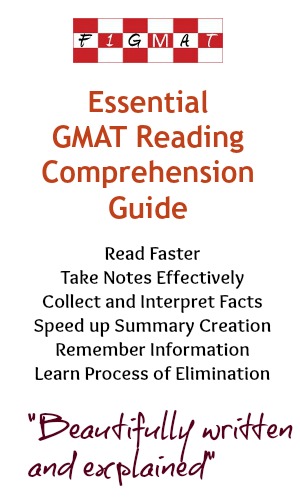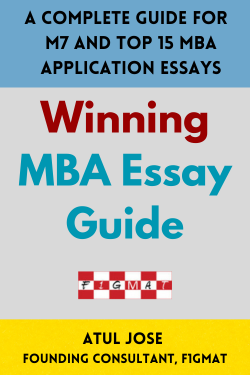 With the GMAT main idea question, the test makers want to understand how good you are in getting to the gist of the passage. The best strategies to follow are:
With the GMAT main idea question, the test makers want to understand how good you are in getting to the gist of the passage. The best strategies to follow are:
1) Don't get lost in the details
Most GMAT test takers spend considerable time reading the entire passage in detail and try to understand every minuscule fact mentioned in the passage. This approach is counterproductive. Skip through the details and focus on the intent.
2) Summarize each paragraph
Once you have read the paragraphs, summarize each of them. The summary of each paragraph should cover the central idea of the paragraph.
3) Paraphrase the main summary
Try to paraphrase the main summary from the summaries of each paragraph. Sometimes the main idea is explicitly mentioned in one of the summaries, and sometimes it would be hidden in the summaries.
4) Eliminate and Select
Now go through each answer options and eliminate options that are irrelevant, out of scope or that tries to generalize or classify the summary to a smaller category. Select the answer option that is most close to the paraphrased main summary, and voila you cracked the main idea question.
Let us look at an example:
<Start of Passage - GMAT Main Idea>
Mitt Romney, the Republican candidate for the 2012 US Presidential elections, is a successful Businessmen, who founded Bain Capital in 1984. His involvement in bringing Bain and Company out of debt was the reason why Bill Bain, the founder of Bain & Company, helped Mitt raise $37 million for Bain Capital. The first major investment was Staples Inc. in 1987 that yielded more than five times the initial investment. Once Bain Capital began to gain traction from the initial start-up investments, they diversified the investments to leveraged buyouts.
As with any private equity Business, leveraged buyouts have little concern for employee retention or welfare. The goal is to maximize the value of the assets that often involve massive layoffs after acquisitions. Managing public fund as a president requires a different skill set. Short-term loses and failure to win second-term presidential elections, are risks that presidents after the 2008 financial crisis must take. The crisis is different from the dot-com crisis in 2000 or the financial crisis in early 1980. The previous instances were the result of bubbles, where speculators raised the value of the asset to disproportionate highs, and when businesses failed to deliver, the bubbles burst. 2008 crisis is the result of institutional failures, which trickled down to other global economies. Presidents after 2008 will have very little control over global economies, and the promise to bring the economy back will take years to fulfil.
The election of Barack Obama in 2008 coincided with the financial meltdown. It was a historic moment in American democracy. Obama was the first African-American president to win a US presidential election. The promise of ‘Change’ galvanized American public and led Obama to a massive win in the elections. The promise of 'change' meant speedy execution and effective change in administration. But the fact that key personals in Obama’s team were from Wall Street didn’t help the president's quest for change. Public opinion was against Wall Street bankers; they triggered the 2008 crisis. Several retirees lost their pension funds and life savings. The news that large bonuses were paid for bankers from the bailout money didn’t help Obama’s image.
However, Barack Obama’s achievement can be summarized in one significant law - The Patient Protection and Affordable Care Act (PPACA). He introduced the law with the goal to alleviate the healthcare cost of the less privileged individuals in America. The law is the first major reform or “change” in Healthcare system, aimed at providing a number of benefits for uninsured Americans, namely subsidies for the individual and tax credits for employers who increase the coverage. Insurance companies are required to provide the same rate for individuals regardless of their credit history, gender, or previous medical conditions. Although the cost for healthcare will increase in the short-term, the long-term benefits in reducing deficits and Medicare spending will be sizable.
<-End of Passage - GMAT Main Idea->
Q) What is the main idea of the passage?
a) Mitt Romney is a better presidential candidate
b) Barack Obama made several bad choices that have weakened his chance for re-election
c) Although Barack Obama didn’t live up to the expectations of the voters, he introduced a significant law for the people of America.
d) With a background in Leveraged Buyouts, Mitt has a better long-term view for America.
e) US Economy will take several years to recover fully.
Answer - GMAT Main Idea
If you have followed our advice, you will soon realize the importance of not getting lost in the details. So as a quick recap, here are the tips:
1) Don’t look into details
Especially paragraph 1 where the author gives us some background about Mitt’s achievements. The question here is about the main idea, so we don’t have to worry about the details
2) Summarize and paraphrase each paragraph
Paragraph 1: Mitt Romney, the presidential candidate, is a successful Businessman who entered the leveraged buyouts business.
Paragraph 2: Leverage buyouts have little concern for employee retention or welfare. Presidential candidate required empathy (implied). Comparison of the financial meltdown of 2008 with 2000 and 1980.
Paragraph 3: Barack Obama made some bad choices in selecting his team and monitoring the utilization of the bailout money.
Paragraph 4: The Patient Protection and Affordable Care Act is a significant achievement for Barack Obama. However, the true benefits will be seen in the long-term.
3) Eliminate and Select
What is the main idea of the GMAT passage?
Here are the answer choices
a) Mitt Romney is a better presidential candidate
This is not implied in the passage. Eliminate.
b) Barack Obama made several bad choices that have weakened his chance for re-election
Paragraph 3 mentions the bad choices, but it is not the main idea of the passage. Eliminate.
c) Although Barack Obama didn’t live up to the expectations of the voters, he introduced a significant law for the people of America.
The author clearly indicates that Obama didn’t live up to the expectations, but the PPACA is a significant law with a long-term view. Keep it.
d) With a background in Leveraged Buyouts, Mitt has a better long-term view for America.
Although Leveraged Buyouts experience gives Mitt an edge, presidents must take decisions with human welfare in mind. Eliminate.
e) US Economy will take several years to recover fully.
Paragraph 2 mentions this fact, “Presidents after 2008 will have very little control over global economies and the promise to bring the economy back will take years to fulfil,” but it is not the main idea of the passage. Eliminate.
Correct Answer: C
 With the GMAT main idea question, the test makers want to understand how good you are in getting to the gist of the passage. The best strategies to follow are:
With the GMAT main idea question, the test makers want to understand how good you are in getting to the gist of the passage. The best strategies to follow are:

